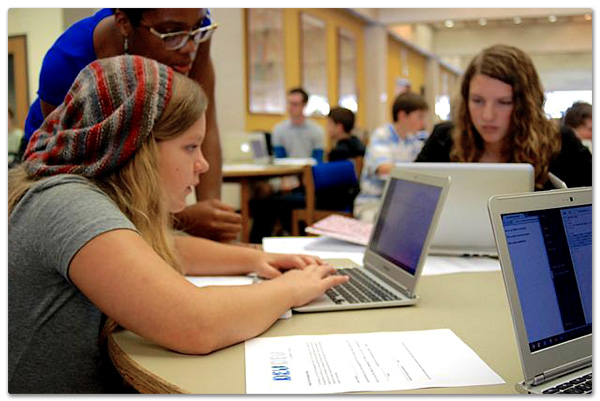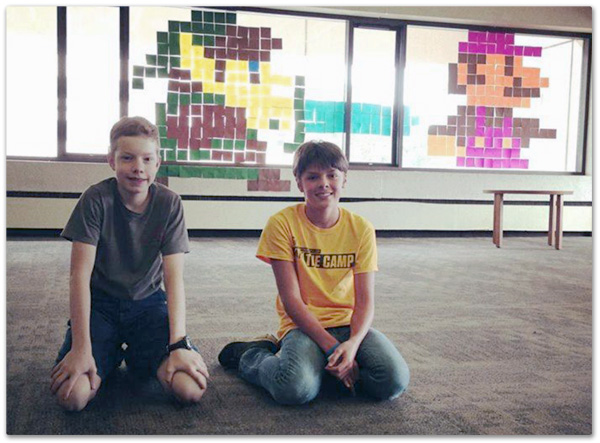The most important resource for creating a successful library maker space—whether in a school or public library—is one’s own community, according to librarians Justin Hoenke, Amy Koester, and Michelle Cooper. Strong relationships and community involvement, not big budgets and high-tech gadgetry, are key to reaching children and teens, the trio of makers say.
The experts shared details of their programming for kids and their top maker strategies during “The Community Joins In: Library Maker Spaces,” a midday session of The Digital Shift: Reinventing Libraries (#TDS13) webcast on October 16, moderated by Hoenke, the new teen librarian at the Chattanooga (TN) Public Library and 2013 Library Journal Mover & Shaker. And since the event, the trio has created a Pinterest page filled with maker space advice, links, and takeaways.

Kids learn to code at Chattanooga Public Library’s DevDev summer code camp, 2013.
Above all, when starting a maker program, “you have to listen to what the community wants,” Hoenke says. “Is it really a 3-D printer?” When Hoenke joined Chattanooga’s staff about six months ago, he explains, he moved his office to the public library floor out near the teen area, so he could spend more time interacting with patrons. “I listen to what everyone says when they come in, notice where they go.” Often, he says, “it’s to the button maker—so that taught me a hands-on element [was] really needed.”
Maker spaces are the “big shiny idea out in library land,” notes Koester, children’s librarian at the Corporate Parkway Branch of St. Charles City-County (MO) Library.
The concept has become “more and more relevant as an addition to a community,” she says, as budget constraints have led public schools to cut special classes like woodshop, and as classroom time becomes more focused on testing to the exclusion of such hands-on learning activities as science experiments and building historical dioramas. “Rigid school requirements have forced out kids being makers,” Koester says. “The library fills that void.”
Reaching out
Koester says she routinely visits some of the local schools in her area in order to develop working relationships with their librarians and teachers, especially the art teachers. “They’re a great source of information on where the [public] library can fill in the gaps,” she says.
Cooper, school librarian at Henderson (TX) High School, also recommends this approach. She urges school librarians to seek partnerships with the public librarians serving young people in the community. “Let them visit with the kids and find out what they are interested in,” she adds.
As a newcomer to Chattanooga, Hoenke says he also went around town and introduced himself. He advises librarians to encourage parents and other community members to volunteer at the library, and to join the library’s board or friends group. “Tap into the talents of people in your communities,” he says.
For Cooper and Hoenke, another source of volunteers is right at their fingertips: their teens. Reaching out to teens and allowing them to lead activities in whatever areas that they enjoy—such as videogames or even fantasy games as Dungeons & Dragons—allows them to be the experts, Hoenke says. “Give them a real purpose in the library,” he says. “Make their volunteer experience rewarding.”
And public libraries with fewer resources, adds Koester, can also benefit from this bottom-up approach, especially if they are staffed largely with paraprofessionals or volunteers. “You can still impact programming in your community,” she says, advising staffers to lead with their own interests.
Does anyone at your library like to knit? Does anyone have kids, and could offer a Lego program? These are easy activities to be incorporated in a fledgling maker program, allowing a library to introduce the concept “in a way that’s not overwhelming or foreign to staff,“ Koester says. She also recommends that paraprofessionals check out Infopeople for its online training programs.
Keep it simple
For the youngest children, maker activities can be very basic, says Koester. Story time crafts are the easiest of these to conduct, with the library providing supplies and kids creating whatever they choose.
“It doesn’t necessitate high level expertise or equipment. Those resources not vital,” she says. Instead, focus on “open-ended activities, not rigid rules or products,” she notes. “Infuse your programs with a maker element by allowing kids to interact in multiple ways at their own pace. Have a variety of tools, informal learning, and child-directed creation.” Koester also advises that libraries structure longer blocks of time for kids to partake in these activities. “Keep spaces open,” she says.
Some of Koester’s favorite examples are a Lego club, a gingerbread workshop (a “highly modifiable” activity, she notes), holiday card-making workshops, and “Marble Run Mania,” in which kids use recyclables to build their own temporary racetracks. “It’s a really engaging maker experience” at very little cost, she says. One of her library’s cheapest, yet most successful, activities was a STEAM program that focused on aliens, in which kids used recyclables and leftover craft supplies to create their own characters. “That was exciting for the kids and entirely free,” she adds.
Cooper also relies on the arts to kick-start creative learning with her older students. “Anything you can imagine—origami, art, music, storytelling, culinary arts,” she encourages. At Henderson High School, “we focus on STEM to learn critical thinking skills, problem solving, etc.” One of their latest projects combining all of these elements is in partnership with the school’s science teacher: students are creating chairs out of newspaper that must support a percentage of their body weight.
If you’ve already established simple making as a concept in your library, where can you go to amp up the learning? Cooper suggests tapping local businesses and civic groups to sponsor various maker activities that might require more funding. “There are also some grants, like Lego Education, the National Science Foundation, Lowes Toolbox for Education,” she says.
The next level
In libraries that are ready for more high-tech making, partnerships make it possible, says Hoenke.
For example, the Chattanooga Public Library this summer hosted DevDev (Developing the Developers), a daily four-week coding camp for 50 teens, where they learned HTML, CSS, computer program of robots, and the coding language Python for game development.
“All this is not something I could pull off on my own,” Hoenke says. “We partnered with four organizations: Engage 3D, a local tech/education startup; 4th Floor, Chattanooga’s new beta space; AIGA Chattanooga, a national org with a local component, who provided the branding and logo; and the Benwood Foundation, for 55 Google Chromebooks and some robots.”
The Benwood Foundation also paid for some instructors for the program, but Hoenke and Chattanooga librarians also pitched in, he notes.
Notably, DevDev included non-tech activities that were physical and hands-on, Hoenke says. “It’s not just about technology. It’s about getting your hands dirty. It’s not just sitting at a computer.” The kids created pixel art murals using origami paper and tape, experimented with “programming” each other (writing out instructions on paper for each other to follow), and spent lots of time with Chattanooga’s button maker. “We made 7000 buttons at the library,” Hoenke says.

Kids at Chattanooga Public Library’s DevDev code camp show off their low-tech paper mural.
DevDev’s teens also went on field trips to the 4th Floor (to see its 3-D printers) and to Engage 3D to learn about the tech business. The program culminated in celebration of the kids’ work right in the library space. Says Hoenke, “Teens love to show off, and their parents love to watch them show off.“
Marketing the making
The urge to share all that they’ve created is also true for younger kids—and makes for great marketing of your library’s maker efforts to your community, adds Koester. She recommends creating a display space for kids’ projects or, alternatively, photographing their work and sharing on social media. Be sure to tell parents that they can see and share these posts with others on Facebook, for example. Another option is to have gallery showings of kids’ works for set periods of time.
Advises Cooper, “You must promote your event!” She recommends newspaper briefs, advertising on the library’s website, placing flyers—created via free tech tools like Smore—in the window of local businesses, and approaching local radio stations, who may donate air time for quick announcements. “Really promote and get the word out,” she says.
“It’s important to market to everyone,” Koester adds. “Regardless of rural or urban, you are a part of that community. At the grocery store, the ball park, the farmers market—make yourself accessible as a representative of the library. At the bank! Talk to the tellers about programs; that can have a big impact.”
And Hoenke recommends promoting to parents and teens wherever they hang out, whether that’s in town or online, such as on message boards devoted to education and homeschooling, he says, noting that the word library carries a lot of weight. “We need to support each other to make this move forward.”
The Digital Shift: Reinventing Libraries webcast is archived online in its entirety, including each program’s presentation slides. A simple, and free, registration will allow access to each session.


